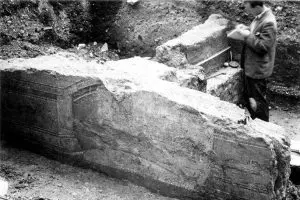30 June 2023 – UPDATE!! I have published an article on the BBC that covers my interpretation and recreation of this spectacular find: https://www.bbc.com/travel/article/20230629-adoreum-the-newly-discovered-flatbread-fresco-of-pompeii
Just a few hours ago, on 27 June 2023, the Archaeological Park of Pompeii announced that a fresco depicting the Roman flatbread known as ‘mensa‘ has been discovered during the ongoing excavations of Insula 10 of Region 9! …And I am so excited that I cannot go back to sleep! (…it’s 3:24 am in Malibu).
Mensae (sing. mensa) were flatbreads — regarded as the precursor to pizza by some — that were once thought to be used as an edible plate or a utensil in the Graeco-Roman Mediterranean. Once the toppings were consumed, the bread base was then eaten as well. Also the Latin word for ‘table’ or ‘altar’, Virgil describes enjoying mensae in The Aeneid: “After Aeneas and his men eat their meals off the flatbread, they remark, “Oh, look! we are eating our tables too!””
Fresco of mensa atop a silver platter from Insula X, Region IX. Photo: Pompeii Parco Archeologico (2023).
The reason why this discovery is so important (and why I cannot sleep right now) is three-fold: it demonstrates the first pictorial representation of foodstuffs placed atop a circular flatbread in a Roman setting, corroborating the literary references to mensae; it helps to identify another flat-bread depicted in a different food fresco at Pompeii; and it provides information on the morphology and manufacture of mensa! Stay with me here because this is really big news!
Previous to this recent discovery, mensae have been depicted at Pompeii in another fresco: the ‘bread distribution’ fresco from the tablinum of the Casa del Panettiere (VII.3.30) (See: image below). In it, we see small, circular flat-breads atop the kiosk shelves on the upper right of the image that can now be identified as mensae. Take notice of the circle that is impressed into the surface of the round flatbreads, creating a trough and slightly raised rim on the surface of the bread. The trough was most likely in place to keep wet food-stuffs contained on the bread surface, preventing it from falling off while it was being consumed. And if you look closely, the trough is also present inside of the slightly elevated rim of the new mensa depiction from Insula 10, Region 9.

Fresco of bread distribution from the tablinum of the Casa del Panettiere (VII.3.30) at Pompeii. Photo: Monaco (2019). Fresco of mensa atop a silver platter from Insula X, Region IX. Photo: Pompeii Parco Archeologico (2023).
In order to create this trough, the bakers would have most likely used a wet finger, or both hands in a C- or cupped-shaped formation, to press the trough into place prior to baking.
…And I guess you all know what I’ll be working on this week!
Story (and recipe!) developing!
**Update: The English version of the announcement is now available on the Pompeii Parco Archeologico web site.









